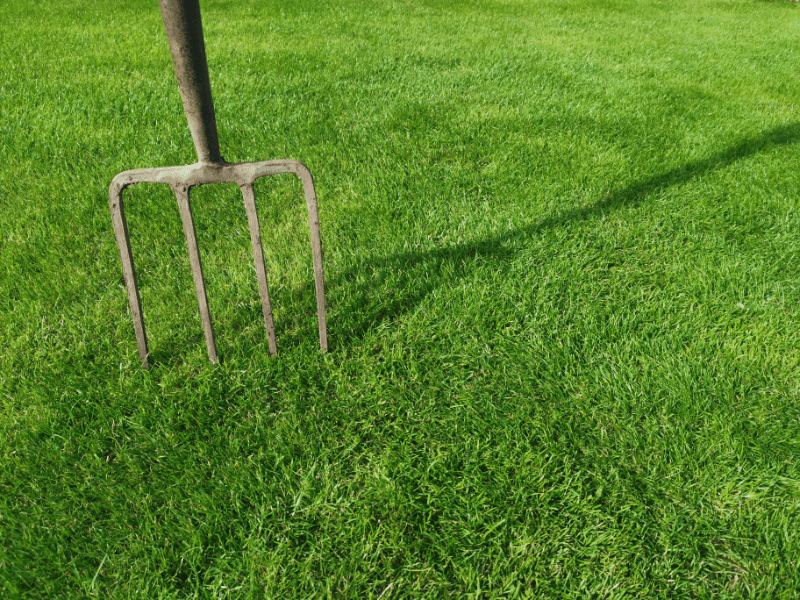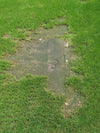
Why, When, and How to Aerate Your Lawn
When it comes to lawn care, our thoughts are that little and often goes a long way. That applies to mowing, watering, and even fertilising. But there are some lawn care tasks that, although less regularly needed, are essential to the maintenance of healthy and resilient grass.
In this blog, we will talk you through the benefits of aeration and how to aerate your lawn.
What is aeration?
Aerating or spiking your lawn is the process of creating small channels of air in order to break down compacted soil, allow water, oxygen, and nutrients to better reach the grass roots, and increase the balance of beneficial bacteria in the soil. In doing so, aerating your soil promotes stronger, deeper, and healthier root growth.
Why you should aerate your lawn
Aerating your lawn helps break down compacted soil and facilitates the penetration of water, oxygen, and nutrients into the ground, which in turn increases the beneficial microbial environment and strengthens the root system. Additionally, well-aerated lawns perform better under severe circumstances of drought and waterlogging.
Bacteria play a vital role in your lawn, helping maintain the health and the efficiency of the lawn’s root system. Soil naturally contains oxygen and nutrients that support a healthy balance of microbes required for a healthy lawn. However, over time soils can become compacted, and when this happens, the natural supply of nutrients, water, and oxygen is reduced, negatively impacting the healthy microbial environment.
How often should you aerate your lawn?
We recommend that lawns are aerated once a year as a minimum. As a highly beneficial process for your lawn, aeration should be carried out as often as necessary.
Heavily compacted lawns, areas used as footpaths, and shady areas will require more frequent care due to heavy wear and a lack of air movement, in which case aeration can be carried out up to six times a year .
When should you aerate your lawn?
Just like scarification and other yearly processes, aeration is a fairly stressful procedure for your lawn, and it should be carried out during periods of growth, when the grass plants can quickly recover.
For cool-season grasses, like the ones commonly found in the UK, aeration should be carried out during early spring or autumn, while warm-season grasses should be aerated during late spring.
Before getting started, make sure to watch out for the weather forecast, and try to match your aeration to a week of good weather, as heavy rainfall will wash over the soil and block the channels created during the aeration process, defeating the purpose.
How to aerate lawn?
Depending on the size of your lawn and condition of the soil, aeration can be carried out either by hand or machine aerator. On most occasions, using a garden fork is the simplest method of aeration for average-sized garden lawns. Whichever method you choose, there are a few tasks to carry out before and after the process that will ensure that your lawn gets the most out of it.
Prepare your lawn
It is a good idea to mow your lawn a few days in advance, remove any debris and obstacles, and check for underground hazards like ground pipes. Additionally, if your lawn is in need of dethatching, you should scarify before you aerate.
Prepare your soil
Watering your lawn a day in advance, or waiting for the day after a rainshower, will make the process of aerating far easier than trying to break through dry, hard soil.
How to aerate your lawn by hand
There are a number of dedicated tools you can use to aerate your lawn by hand, including spiking shoes, manual spike aerators, and manual core aerators. But in most cases, a garden fork will do the job.
To aerate your lawn using a garden fork:
- Push your garden fork roughly 6 inches deep into the soil
- Push forward as you remove the fork from the soil. This will help make the holes slightly bigger, and create further cracks for aeration, as well as allowing you to easily remove the tool from the soil.
- Continue this process, spacing the holes around 5 to 6 inches apart, until you cover the whole surface of your garden.
Using a machine aerator
Machine aerators can be hired from lawn and garden centres, and are equipped with either solid or hollow tines. Machine aerators are ideal for bigger gardens, as they make the whole process easier and less time consuming.
For heavily compacted gardens, we recommend using a hollow tine aerator. These kinds of machines pull cores of soil from the ground in order to create space for the rest of the soil to move and decompact. The size and depth of these cores depends on the type of machine used.
To use a hollow tine aerator:
- Go over the surface of your lawn in parallel straight lines where possible, just like if you were mowing.
- Aerate the perimeter of your lawn last, to ensure that you are not turning over an already aerated area.
- Once you’re done aerating, go over the surface of your lawn and check for any plugs that may still be in their holes, removing them to free the channel of air.
- Let the plugs dry on the surface of your lawn. Once dry, they can be broken down and evened out with the soil, to ensure that all the nutrients return to your lawn.
After aerating
To maximise the benefits of aerating, we recommend that you apply a top dressing to your lawn, which will help further improve the quality of your soil by adding needed nutrients and minerals to its composition.
Post-aeration is also the ideal moment to overseed and fertilise, especially if you also scarified your lawn beforehand. This will help your lawn reestablish itself and reach its full potential.
Finally, it is important to maintain a regular watering and mowing schedule throughout the year, to reap the full benefits of an intensive care process like aeration. For more tips on caring for your lawn, check out our lawn care blog.
About So & Mo
With over 30 years of experience in maintaining some of the finest gardens in the UK, at So & Mo, we are passionate about helping you maintain your healthy lawn lush and healthy.
We know that finding the right lawn care products can be confusing, which is why our Performance Liquid Lawn Feed is delivered as a 12-month plan of 6 feeds engineered to work with your lawn throughout the seasons, delivering year-round performance.
For even more tips and information on how to look after your lawn, visit our blog to get insights directly from the experts!
Ready to be proud of your garden?
Ensure your lawn never goes hungry with our personalised feeding plan. Delivered through you letterbox exactly when you need it.





